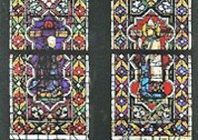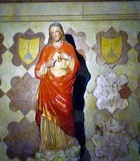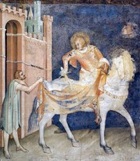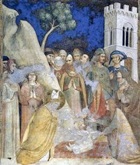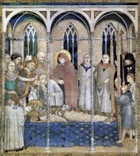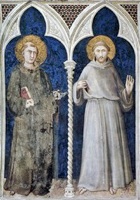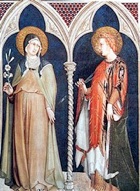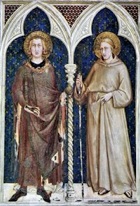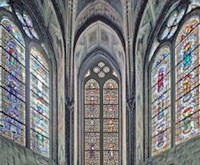In 1312, the Franciscan Gentile Partino da Montefiore, Cardinal Priest of San Martino ai Monti in Rome, visited Assisi on papal business (as described in the page on San Francesco in the 14th Century. A document from his account book that dates to this time (now in the Vatican Archives) records the expenditure on his behalf of 600 gold florins “for a chapel that he is having made in San Francesco”.
A number of references to Cardinal Gentile in the Cappella di San Martino suggest that this was the chapel in question:
-
✴He is twice depicted as a donor (as illustrated above):
-
•in the fresco on the entrance wall , he kneels in his Franciscan habit before St Martin of Tours, with his cardinal’s hat to the right; and
-
•in the stained glass of the chapel, he kneels, dressed as a cardinal, before St Martin (Pope Martin I).
-
✴His arms appear:
-
•between the busts of saints to the sides of the windows; and
-
•in the stone panels that decorate the lower part of the chapel walls.
The architecture of the chapel was based of that of the Cappella di San Nicolò, which Cardinal Napoleone Orsini had built specifically as a funerary chapel. It seems likely Cardinal Gentile had the same function in mind for the Cappella di San Martino. However, when he died later in 1312, he was buried in the Cappella di San Ludovico opposite, which suggests that the Cappella di San Martino was unfinished at that time. The earliest surviving documentation of chapel dates to 1355, when two artisans were paid for working on it.
Frescoes (ca. 1316-7)
The frescoes in this chapel were first attributed to Simone Martini in 1820, and this is now widely accepted. Cardinal Gentile stopped at Siena just before his death at Lucca in 1312, and he might have seen works by Simone there that no longer survive. However, the frescoes at Assisi were almost certainly executed a few years after his death: they are thought (on stylistic grounds) to post-date the Maestà in the Palazzo Pubblico, Siena, which bears the date 1315 and was the subject of regular payments until December of that year. It thus seems likely that the (unknown) executors of Cardinal Gentile commissioned the work in 1316.
The frescoes on the entrance arch were the last frescoes in the chapel to be painted. As set out below, these were probably imposed on an earlier design soon after the canonisation of St Louis of Toulouse in 1317. This suggests the intervention of Angevin patrons intent upon commemorating the addition of a new saint to the family pantheon.
Scenes from the Life of St Martin of Tours
St Martin of Tours, who was born in Pannonia (Hungary) in 4th century, abandoned a successful military career in order to dedicate his life to religion, and subsequently became Bishop of Tours. His legend was written by his contemporary, Sulpicius Severus and elaborated in the Golden Legend (ca. 1265) by Jacobus de Voragine. His tomb at Tours was an important place of pilgrimage from at least Carolingian times. There is no known precedent in Italy for the composition of the fresco cycle at Assisi. Nevertheless, evidence of the importance of the cult in the 14th century is provided by the facts that:
-
✴Pope John XXII instituted the feast of the translation of the head of St Martin in 1323; and
-
✴King Robert apparently commissioned a similar cycle of frescoes for the Castel Nuovo, Naples in 1343.
The frescoes at Assisi depict:
-
✴on the lower left wall:
-
•St Martin sharing his cloak with a beggar (illustrated here); and
-
•Christ appearing to St Martin in a dream carrying the cloak, to reveal that He had been disguised as the beggar in question;
-
✴on the lower right wall:
-
•Emperor Julian knights St Martin (illustrated here); and
-
•St Martin renounces his weapons and faces his enemy under the protection of a cross;
-
-
•St Martin resurrects a dead child (illustrated here); and
-
•the dream of St Ambrose, in which he foresaw the death of St Martin;
-
✴on the upper right wall:
-
•an angel appears to St Martin as he celebrates Mass, carrying the cloak that he had given to the beggar (illustrated here); and
-
•the Emperor Valentinian kneels before St Martin (on the left) because, after he had previously refused to receive him, he had been hit by a bolt of fire (on the right); and
-
✴in the vault:
-
•the death of St Martin; and
-
•the burial of St Martin, where St Ambrose officiates (illustrated here).
Frescoes on the Entrance Arch
As noted above, these figures of standing saints under the entrance arch were the last to be painted. They depict (from top left to bottom right):
-
•SS Anthony of Padua and Francis;
-
•SS Mary Magdalen and Catherine of Alexandria;
-
•SS Clare and Elizabeth of Hungary; and
-
•SS Louis IX of France and the newly canonised
Louis of Toulouse, depicted against a backdrop with the Angevin arms.
Some of these figures were overpainted before the work was complete, and their identities changed (as described by P. Leone De Castris - referenced below). For example:
-
✴the figure of St Elisabeth was adapted from one of St Ursula;
-
✴that of St Louis IX of France was pained over a saint dressed in white; and
-
✴the figure of St Louis of Toulouse was adapted from one of St Antony of Padua, which required a Benedictine saint opposite St Francis to be adapted to depict St Antony of Padua.
The most likely explanation is that these saints, which all had particular significance for the Angevin family, were imposed on the programme to celebrate the canonisation of St Louis of Toulouse in 1317. (These frescoes would thus be broadly contemporary with the altarpiece of St Louis of Toulouse, which was another Angevin commission made at this time. The wider subject of Angevin patronage in San Francesco is described in the page on San Francesco in the 14th Century.
Stained Glass
The stained glass in three large two-light windows of the chapel is attributed to Giovanni di Bonino, in association with Simone Martini. The main fields depict single figures, identified by inscription as (from the top in each case):
-
✴on the left:
-
•SS Gregory and Martin of Tours;
-
•SS Francis and Nicholas of Bari; and
-
•SS Rufinus and Stephen;
-
✴in the centre:
-
•Christ and the Virgin;
-
•SS Martin of Tours and Peter; and
-
•Cardinal Gentile kneeling before St Martin (as illustrated above);
-
✴on the right:
-
•SS Jerome and Paul;
-
•SS Damian and Martin of Tours; and
-
•SS Antony of Padua and Laurence.



